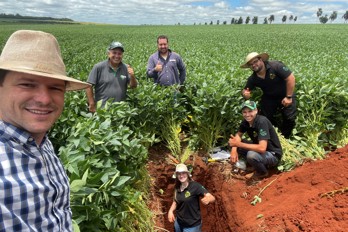As a Group we have great interest in research and development in improving agricultural techniques and following the best current practices by working in ways which allow commercial agriculture to become more sustainable and realise the benefits of working with the natural environment.
OUR TANZANIAN FARMS
The Group’s recently acquired farms in Tanzania have presented an opportunity to explore the benefits that regenerative agriculture can bring.
Prior to the Group taking over the farms, they were used for livestock operations with much of the land under pasture. The challenge was to establish the avocado orchards whilst maintaining the integrity of these pastures and not removing the soil cover. Ploughing up these pastures would have led to degradation of the soil structure, release of carbon and exposing the soils to the risk of wind and water erosion.
With over 30 years' experience living and working in Tanzania, Luke Edwards, Managing Director of Eastern Produce Tanzania, has a wealth of knowledge from agricultural engineering to corporate agriculture specifically in cereal production, where zero till techniques are prominent. The aim is to plant the avocado orchards using regenerative agriculture techniques taking a holistic approach, working with nature rather than against it to establish a biodiverse ecosystem within the orchards, creating a perfect environment for producing healthy, productive and sustainable avocado crops.
"Agriculture has gone full circle. 50 years ago biodiversity was inherently part of the agricultural production system with rotations and mixed livestock and cropping farms, by the 70's it was much more industrialised and focussed on mono- cropping and now we are going back to where we came from with an understanding of the reasons for it."
Luke Edwards, MD, EPT
THE PROCESS
1. ZERO TILL, NO TILL
The goal is to minimise the impact on the soil from the very start of development. The avocado seedlings are established by mowing the pastures, using a targeted single line rip and cross-rip to loosen the soil, and then planting the seedlings on mounds. This only affects the areas necessary for planting and keep as much of the orchards covered in grasses as possible thereby minimising any bare soil which might lead to soil erosion, promote weeds, and release carbon.
2. INTERROW CROPS
Various species of cover crops will be planted between the rows of avocado trees which will improve the flora and fauna biodiversity of the orchards. This approach has multiple benefits.
Firstly, improved flora and fauna biodiversity increases the populations of pollinators which are especially important in the production of avocado.
Secondly, by having multi-species interrow crops there is more root mass and greater microbial activity in the soil; this leads to healthier soils and healthier plants that are less susceptible to pests and diseases leading to less pesticide and inorganic fertiliser usage.
Thirdly, improved biodiversity also promotes natural predators thereby reducing the need for pesticides.
AGRICULTURE & SCIENCE WORKING HAND IN HAND
Planting an orchard from scratch in Tanzania is allowing us to use the current best practices in agronomy to maintain soil health in establishing avocado orchards.
Initial soil samples were taken across the whole area when the farms were first purchased and in two years-time second samples will be taken. This will give a good indication of how our planting techniques and cover crops have impacted the soil, specifically the levels of organic carbon matter and cation exchange capacity.
DAILY ORCHARD MANAGEMENT
A more targeted approach will be used for the orchard's day to day management. Scouts regularly assess the orchards tree by tree and inputs are applied to remediate specific issues. Yield can then be assessed per tree rather than the broader measure of yield per hectare.
It is anticipated that there will be a significant reduction in water requirements due to having plant “cover” around the trees at all times, augmented by the use of thick layers of mulch. One of the components of this mulch currently being investigated is the use of rice husk; this has a very high silica content and therefore does not break down quickly. In order to further ensure maximum water use efficiency the operations use micro-sprinklers to make sure that the right amount of water gets to the trees’ roots as quickly as possible.
The use of heavy layers of mulch, particularly rice husk, also act as a blanket thereby reducing weed pressure and reducing erosion at the base of the trees.
SHARED KNOWLEDGE ACROSS OUR GLOBAL OPERATIONS
It is hoped that the work at our Tanzanian operations will aid our understanding of how we can potentially modify methods across all of the Group’s operations to better work with nature and minimise our environmental impact whilst maintaining yields and quality produce from our various tree crops.
Graham McLean
Managing Director Agriculture at Camellia Plc



